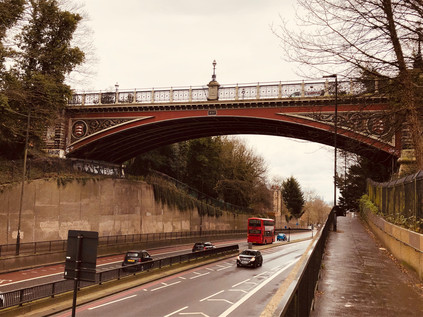
London Ordinal: The A1 - Walking into the Light
Posted in London on Saturday 12th January 2019 at 11:01pm
A month ago I didn't expect to be here in London. Arriving at the bustle of Paddington station on one of GWR's flagship new trains for the first time, I was a little early. The skies over Berkshire had seen a reassuring red dawn fade into a marine silver sheet which didn't bode well, but otherwise, things had gone to plan so far. I wasn't used to this - it had been a month of confounding twists, difficult turns and unwelcome disappointments. The turn of the year had seen our annual trip - always a highlight, and despite being a little shorter and more austere this time around, a welcome break from the routine. A plunge back into a fractious and grumpy working environment where the low rumble of national politics invaded every decision had made for a difficult week too. Delay was everywhere, inaction was the standard response. I was itching to get walking again. I didn't linger at Paddington, heading directly for the Circle Line and hence to Kings Cross St. Pancras. I was there only long enough to charge my coffee cup, grab a swift but unusually fancy breakfast, and head down onto the Thameslink platforms with BTP officers slaloming around me to apprehend some early fare-dodgers who'd somehow spoofed the gateline. As they dashed around the corner towards the stairs, one of them carefully discarded his takeaway espresso cup to better make pursuit. It was good to be back in London: outwardly civilised but always on the brink of something. As my train snaked into the station and we escaped from the tunnels somewhere north of Thomas Hardy's graveyard packed with human jam, a grey morning opened before me. A new year and a new project. Time to get moving, again, at last.
My journey out of London was the usual experience: as the interval between the suburban stations began to lengthen, more greenery crept into the window views. The sprawling city relaxed like a muscle, its margins ragged and ill-defined. I disembarked at Elstree and Borehamwood. Outside the official administrative margin, but still inside the concrete circlet of the M25 - at least, just inside... I didn't know this part of the world at all well. It was a map-smudge between Barnet and Edgware which remained unexplored, and despite being formally and spiritually in Hertfordshire, it felt perhaps more like a suburban satellite than some of the towns which had arbitrarily crept into London in the 1965 redefinition of its boundaries. While Enfield and Barnet felt like small, independent market towns which had only accidentally strayed into the city's ambit, Borehamwood felt exactly like a suburban enclave should. I navigated out of the station car park with some challenge and set off along the High Street - a haphazard grouping of national chains and local traders inhabiting a dissonant mix of 1930s shopping parades and 1990s plastic-fronted retail centres. It was busy and self-contained, and in the unexpectedly temperate January morning, not a bad place to start walking. I peeled off to the south long before the strip of shopping opportunities had ended, heading into the residential hinterlands with their mix of bungalows and modern church buildings. The road leered above me, a long straight row of tail-lamps rising ahead of me into the trees. Borehamwood ended slowly, persisting along the road out of town. Cresting the hill, I saw my route creeping in from the north to converge with my current bearings. My target today had, in fact, suggested itself a long time back, but felt like the wrong walk back then. I didn't want to be that road walking guy who endlessly recounted treks along the byways of London for their own sake. There were two considerations though: firstly, I was that road guy - a consistent string of ambulations focused on routes ancient and modern proved it. Secondly, I'd probably always been thus. My earliest memories are of lying on the living room floor puzzling out an interchange or scratchily drawing Primary Route signs after Kinneir and Calvert. But after all, who cared anyway? No-one was reading. I could walk wherever I wanted, write whatever I felt and remain largely unashamed of my preoccupations. I felt a sudden flush of freedom when I was pondering my walk on the train into London this morning. I was going to begin a new year with a new plan: five long walks along the principal A roads leading into London. All of them converged on the shifty, ill-defined 'Centre' of the city. All of them crossed the boundary at an inconvenient and distant spot somewhere in the scrubby, semi-industrial edgelands. This was just my kind of walking. At Stirling Corner, after visiting the local branch of Morrisons where sleepy Saturday-morning people appeared intent on crashing and colliding into each other with an alarming lack of care, I finally found the A1 arriving fresh from its bypassing of Borehamwood. A fire engine howled around three-quarters of the roundabout, quicker than braving the traffic lights and turning directly south. Traffic momentarily stopped and pulled aside, then ebbed back into the space it had left for the emergency vehicle as if nothing of note had happened. To the left, the road was simply signposted 'The NORTH', to the right the familiarly abbreviated 'C. London' which I always seemed to be heading towards - I crossed the busy carriageways gingerly and began walking. The next sign told me it was five miles to Brent Cross and twelve to Central London, while the clouds closed in overhead to form a grey, sound-deadening mass. Cap pulled tight and head down, I set off along the narrow footway beside the litter-strewn laybys which signalled my passage out of the Home Counties and into Greater London.
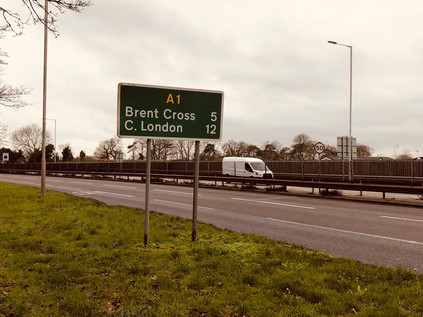
The road was broad but divided into narrow lanes which pushed the slower moving juggernauts closer to my path. I hugged the margin of bushes carefully, trying not to let my shoulder protrude in case of a stray wing-mirror. Having walked some fairly major routes around the city, this felt more precarious than any so far. The tarmac scythed through a patch of green - to the east, the public open space at Moons Moat, damp and edged by a forest of leafless, intertwined trees which presented a grim barrier against the road. To the west, a golf course - the scourge of the greenbelt - and then the M1 and London Gateway Services, formerly known as Scratchwood, after the belt of tree-covered hillside here. The services were reached by an aborted junction - a half-finished roundabout which whirled rest-area bound traffic illogically around itself before allowing them access to M&S, Starbucks and the other facilities. The M1 made a dramatic break for freedom here, curving sharply to the west and finally parting company with the railway line it had shadowed for miles out of the city. The history of the motorway and my road are inseparably linked, twin grey lines ploughing north through the lesser-valued patch of north-western suburbs which are not quite Hertfordshire, yet. Just a few days before I'd stood at the corner of Leith Street and Princes Street in Edinburgh - the start, or indeed the end of the A1 depending on your viewpoint. We'd followed its bleak and impressive beginnings south into England on our journey home, twisting into the low grey clouds which hugged the coast. It felt fitting to begin the year on this route. A band of light tinted red by the pinkish grey cloud cover broke through to the south, making the wet pavement gleam. It felt like a premature sunset. I walked towards the light...
I finally got my bearings at Apex Corner. Approaching from the south on my first visit this swirl of traffic had seemed like the end of civilisation, the A1 stretching away into the trees. Now it was a welcome return to suburbia where the road slowed and quietened somewhat, at least temporarily. I edged around the roundabout above ground rather than descending into the subways, and as a result, I witnessed the aftermath of a minor traffic incident. The police were already on scene, cars with deformed plastic fenders askance and airbags hanging flaccidly post-inflation neatly sequestered on the central reservation. I turned south, heading into the environs of Mill Hill. The land climbed to the east, into the rural edges of London which I'd skirted on the A5109 - sleepy Totteridge and the muddy slog over the fields to Whetstone lay beyond. To the west, the landscape fell away into the valley of the Dean's Brook which formed an early headstream of the Brent. The road continued south through suburban sprawl which was neither Edgware nor Mill Hill quite yet, impressive double-fronted houses and gated villas stepped up the bank, away from the road. Some of them had grand entrance stairways sweeping up to their gates, designed for impressive arrivals by equally prestigious motorcar and likely not used now that they provided access only to the litter-strewn carriageway of a shuddering, congested expressway into London. A street of shops led away west to Mill Hill Broadway station, the settlement's spiritual and commercial centre as defined by M&S Food, lying some way from the brow of the hill with its impressive views over West London. Away beyond the northbound carriageway a small knot of red brick civic buildings clustered together - the stocky, almost ecclesiastical tower of Mill Hill Fire Station glowering over the single-storey public library opposite. I continued along the route south, passing the exotic crop of domes which housed the telescopes of the UCL Observatory. Opened in 1929 the low-rise buildings were sleek, whitewashed blocks very much typical of their time, supporting the silvery domes which housed the range of telescopes, the earliest of which was manufactured in 1881 with the most recent installation just last summer. The road bisected the expansive spread of Mill Hill Park, accessed from the A1 only by a gloomy looking footpath leading to a subway linking the two segments of green space. As the road began to rise above the level of the back gardens abutting its course, I experienced the unsettling jolt of recovering a memory: I had scanned this part of the map in detail for a previous expedition. Ahead was a site of double abandonment.
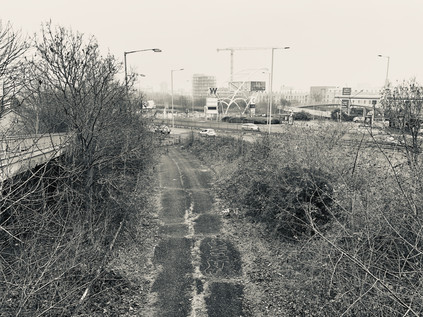
Plans to extend the Northern Line have never fared well, and the interruption posed by World War Two cancelled many of the projects in the New Works Programme which would have seen these northern suburbs better served by the underground, largely by integrating the Edgware, Highgate and London railway into the system. This railway, authorised by act of parliament in 1862, carved an ambitious and costly path into the Middlesex suburbs which were growing over the hills and valleys north of London via audacious tunnels, viaducts and embankments. It also filled a marked gap in the growing Underground map. While the former Palace Gates line is a better-known casualty of post-war austerity, now the Parkland Walk, a further scheme was also cancelled. Currently, some Northern Line trains don't make the awkward curve east towards High Barnet, continuing instead to the rather lowly single-platform terminus at Mill Hill East. Historically, High Barnet was the branch line and this, the mainline, originally reached Edgware by way of the route which passed under the A1 here. The line was near ready for conversion to Electric operation by Northern Line trains when hostilities curtailed the plan. Parts of the route still appear walkable while much has succumbed to encroaching development, but this section of the line's course survived to serve again, becoming the temporary terminus of the M1. Built piecemeal over the course of the 1970s, the route of the motorway into London was a bewilderingly challenging project, the final course of which depended on the plans for the Ringways and the complexities of squeezing a major road into the narrow channel through the hilly edges of the suburbs in which the Midland Mainline already ran. For a time while the politics and practicalities of motorways into urban London were evolving, a temporary terminus was constructed swinging traffic east to join the A1 here, just north of Fiveways Junction. Looking down on the abandoned sliproad, last officially part of the M1 in 1977 when the final section to Staples Corner opened, I was amazed to see a fairly intact road surface and mossy but extant metal crash-barriers below. In fact, the route saw a third incarnation when, following the IRA bomb at Staples Corner in 1992, it was resurfaced and pressed back into use as a terminus for the motorway once again. Maintained as a strategic priority until the early part of the 21st century, the road was now beginning to return to nature once again. A footbridge zig-zagged over the curve as it began its ascent to rejoin the A1, and at the end of the ramp I found a spot where I could scramble over a patch of wet grass to stand on the surface, exit blocked by locked barriers and huge concrete blocks, while the traffic on the A1 unsuspectingly sluiced surface-water towards me. I pondered this tiny rediscovery as I picked my way back to the footpath: my walks were often overtaken by these fragments of microhistory which, taken in isolation, seemed inconsequential. But I found a strange solace in standing on this rather heroic bit of infrastructure which had returned and returned again to serve the ever-evolving transport needs of the capital.
I negotiated the grim, clattering flyovers of Fiveways quickly but was careful to note the group of cast lions standing atop pillars around the junction. David Annand's sculptures, commissioned by the Highways Agency as a foil to the unrelenting noise and inconvenience of the frequently traffic-snarled junction, delighted in the punning title 'Civic Pride'. I ascended a bleak, narrow sliproad to join the traffic braking hard to readjust to urban conditions at the end of a higher-speed trip along the M1, my route rather suddenly changing pace too, and reverting to life as a rather quiet arterial route. Like all approaches to London, the road was flanked with large, mid-century villas which were now forlornly marooned alongside six lanes of traffic, and I trudged through a persistent drizzle along the dusty service roads which was all the separated these homes from the bursts of traffic emitted by the junction. At least the steady mizzle of precipitation kept the dust down. The road banked downhill, navigating its way into the confluence of the Dollis and Mutton Brooks below. The terrain here felt comfortably familiar - I'd previously crossed the route at Finchley Lane, and stalked the course of the Dollis Brook along the valley floor. I knew I was closing in on the North Circular near a point where the walk I'd taken there had begun to feel impossibly long and debilitating. The junction, where Great North Way folded into the North Circular as Falloden Way, was a complex entanglement of traffic signals and lane choices. Traffic approaching it fenced and jostled for position in the correct channel, space was contested and fractious. My irritability with the surroundings was rising too and I felt like I was picking up something of the road's temperament, but I resolved to stick to the tarmac and not use the path along the Mutton Brook as I had on a previous crossing of the valley. This would also allow me to get a look at the impressive frontage of the Finchley United Synagogue. Approaching the building, several things were apparent: firstly that security was very tight - yellow jackets and headsets teemed around the entrances and escorted departing worshippers to their cars. Also, the facade of the building was so impressive that I needed an angle on it. I crossed to the grassy triangle of Charter Green and turned to frame the building in my camera. The vast finned shield gleaming in the grey morning like a huge radiator, pairing with the defiantly lofty sword of La Délivrance, Guillaume's wartime sculpture purchased by Lord Rothermere and insistently sited here to enable him to see it when driving to his mother's home. The moment I clicked the button, the yellow jackets were triggered. As I turned to walk away, they shouted after me and heavy footfalls could be heard. A small group of them joined what was to be a short and low-speed pursuit as I figured that engaging was going to be the better outcome here. They caught up with me on the green and a couple passed by to ensure I was fully encircled. The leader stepped forward, a stocky but well-spoken young man bedecked with badges of authority and communications technology. "Do you know what the building is?" - I agreed I did - "So why did you take a picture of it? Can I see your camera?". I sighed - this all felt predictable and I dreaded writing of it. These challenges by extra-jurisdictional hi-vis have become all too common and are generously over-written. Anyone who dares to walk outside a set of unspoken but apparently acceptable routes will suffer such events at some point. I railed at the thought of having to describe this here, throwing myself open to derision for my hackneyed, privileged white-guy psychogeography yet again. But, however much I bristled the rule is to stay polite and firm - and I did. I first spelt out the deal - yes, they could see my camera so long as we agreed they couldn't remove it from me, handle it or attempt to delete any of the images I'd taken. Also, that despite their well-executed encirclement they had no power to hinder or detain me. A little taken aback by the well-practiced nature of the delivery I suspect, the young ringleader agreed readily - as keen to end the debacle as I. I showed them my litany of dullness: grim shots of a litter-strewn Dollis Brook, crumbling concrete stairs to nowhere, gantry signs above a rain-gleaming roadway. He looked confused but satisfied I was no risk, or at least not to the Synagogue. The yellow jackets relaxed at his relief, hands returned to pockets. They scanned the green for more pressing matters while their leader wrapped things up here. "I'm sorry sir, you'll understand why things are like this just now?". I agreed I did, and that I too was sorry that he needed to apologise for this here, now in Britain. We talked a little more - about how they'd seen protests from both the far-left and far-right, and how the temper of the debate was changing, getting edgier and more directly anti-semitic. We parted on good terms, and he returned to guard the synagogue. That last phrase is something I still find myself surprised and saddened to be writing in 2019.
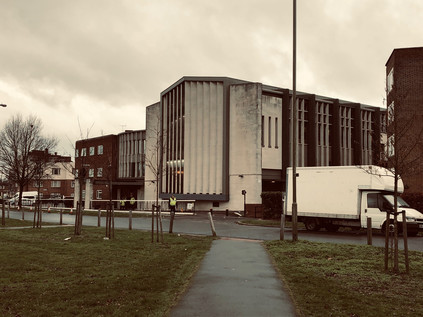
Beyond this encounter the road felt muted and strange. After forking from the North Circular and curving south and east, it also seemed quieter and somewhat less important. This peeling away of traffic as the road crosses significant routes was a feature of London's radials which I'd forgotten until now. Slowly, even the greatest roads towards the City dwindle, and the A1 appeared to have lost a good deal of its strategic heft back at Henly's Corner. Now, the road hugged the valley of the Mutton Brook which wound back and forth under it, occasionally evident beneath a tangle of greenery before it disappeared into Northway Gardens. This stretch of road dated from the First World War, and was built to serve an extension to the model cul-de-sacs of Hampstead Garden Suburb which hugged the contours of Highgate Hill. Founded by Dame Henrietta Barnett who had, with her husband Samuel, also masterminded the Whitechapel Art Gallery and Toynbee Hall, the suburb took its cue from the beginnings of the Garden City movement. The suburb was to be an egalitarian enterprise, providing dwellings for all classes of person in detached houses with gardens. There were to be hedges rather than walls, and the streets would be broad and tree-lined with a much lower density than was then common, even in the suburbs. The homes to the south of the road were fine, cottage-like and attractive - and it's no wonder that the area continued to feature a number of celebrities among its freeholders. To the north of the road, the houses were a little less elaborate and more prosaic, but the magical effect of the suburb seemed to linger over them too. I wandered into the Co-op on busy Market Place and shared my concerns about the poor quality bananas with an elderly but spirited German woman who seemed less inclined than I to let this pass unremarked to the manager. Back out on the road, I ate while I walked, mindful of the time and the challenging distance ahead. I was curious to stray south towards Sir Edwin Lutyens' Central Square with its two churches and impressive school buildings, but that was for another walk. One which might equally stray along The Bishops Avenue which crossed my route nearby. Part of a cluster of streets named for Arthur Winnington-Ingram, one-time Bishop of London and prolific local landowner, this street has become an almost ludicrous proposition: sometimes regarded as the most exclusive street in London, it winds south from East Finchley towards Hampstead Heath and is lined almost entirely by mansions. The list of owners read like an unlikely collision of mid-century British culture (Katie Boyle, Sir Billy Butlin, Gracie Fields) and flat-out crooks (Emil Savundra, Asil Nadir). Nowadays, the properties are in the hands of Sultans and Saudi royals, many of them maintained only as investments in the overboiling property market which London currently provides. They still launder money through this odd little enclave, but it's all above board nowadays. On the A1 though, no such lofty denizens were found - save perhaps for an infant Jerry Springer raised in the sweeping moderne blocks of Belvedere Court - and in fact I realised that I'd seen few people walking at all, even in this relatively pleasant suburban stretch. My route was fast closing in on the old road north - a route I'd crossed and recrossed on my earlier walks through Barnet, Whetstone and Finchley - and now I met it at a dour, choked gyratory where the terraced houses ended in an abrupt demolition plot. The rest of the terrace had long since been cleared for the new road's progress exposing, the internal geometries of the chimneys to Bakers Lane. Here I turned south again, back onto the original route of the Great North Road into London.
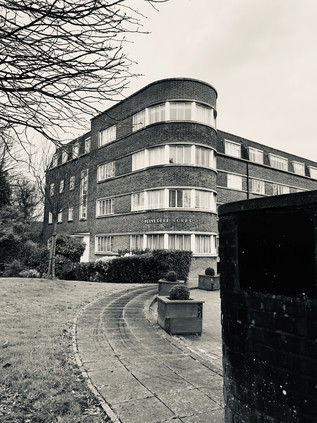
For a brief stretch the road felt familiar - I'd blundered unexpectedly into Highgate once before when navigating between the north and south sections of the Parkland Walk, and then - as now - it was a shock of bustle and pedestrian activity. I jostled with small groups of other human beings at the street crossings, narrowly avoiding properly equipped cyclists in their expensive an unforgivingly tight kit. It's fair to say that I'd hardly strayed from relatively affluent areas of North London on this route, but this felt much more ostentatious. For a while at least, the focus shifted from the grey asphalt strip which had defined the walk to the smells of tiny delis and the chatter of young people outside stores. I was glad to be able to gaze down from the path onto the roof of the decaying surface-level railway station which had once graced the Northern Heights line. Its quiet repose beside this busy street was comforting, and the temptation to plunge into the trees and enjoy the walk along the leafy chasm left by the ghost railway was very strong. Instead, I left Highgate behind, heading south along the deepening cutting of the former turnpike built to avoid the steep hill and originally proposed as a tunnel by engineer Robert Vaizie in 1808. In 1812 the tunnel workings collapsed and it was left to John Nash, the darling of Regent's Park and its Regency terraces, to rescue the project with a brick viaduct above the deep chasm which gave the area the name Archway. Replaced with an elegant cast iron bridge carrying Hornsey Lane in 1893, the crossing still defines the landscape: as the road dipped to pass through the geological outcrop of the Northern Heights, the towers of the city were framed by the flanks of the cutting with the ornate bridge above bearing the arms of Middlesex. London shimmered through the window of the bridge, cloaked in a grey mist with a rosy cloud drifting across an attempt at an early sunset. It was hard not to be awed by the idea of blasting this culvert through the side of a mighty and ancient hill. The hazy view of London in the middle distance brought to mind the legend of Dick Whittington, turning again from these heights to return to London, taking up the office of Lord Mayor three times. The area has subsequently adopted Whittington as its genius loci with a modern hospital bearing his name climbing a substantial way along Highgate Hill. The real Whittington had a more prosaic ascent, and one not so unusual to modern audiences - having never truly been a poor man, he came to the City to turn his hand to trade and then to more lucrative money lending. He gained favour by making loans to King Richard II, and was directly installed as Lord Mayor upon the death of Adam Bamme in 1397. The Crown had previously seized the lands of the City due to misgovernment, and an early act by Whittington was to regain these lands for the huge sum of £10,000. Richard II's deposition and the subsequent reigns of Henry IV and Henry V did little to affect his good standing, and he brought surprisingly modern changes to the medieval City, including facilities for unmarried mothers and a vast public convenience known as Whittington's Longhouse. On his death his generous gifts assured him a place in the memory of London, allowing the building of a library at The Guildhall, extensive rebuilding of Newgate Prison and repair of the crumbling St. Bartholomew's Hospital.
The Turnpike rejoined the old route north at the foot of Highgate Hill where a predecessor of the Whittington Hospital still broods on a corner site. The Holborn Union Infirmary opened in 1879, providing separate accommodation for Male and Female patients in an imposing yellow brick neo-gothic building with tall wings to the north and south. By 1895 the site had already been extended, a pattern which would follow throughout the twentieth century as local need grew and treatment evolved: at some point, glass verandah were added to the south-facing walls of all blocks to allow tuberculosis patients access to sunlight and fresh air. In 1944 the hospital merged with the nearby St. Mary's Hospital and Highgate Hospital to become the Archway wing of the new Whittington Hospital. It remained part of the new NHS until 1980 when functions were centralised on the current Whittington site. The building fell into decay until it was jointly purchased by UCL and the University of Middlesex in 1998 to provide a new campus for health and professional studies. Now it was again abandoned and boarded up: a Victorian imposition in the ever-modernising whirl of Archway. The forlorn, somewhat forbidding building is part future movie set, part sad hanger-on from what the locals will tell you were better times. It's harder to picture this rose-tinted past from the perspective of arrival via the A1 which was once a far less pleasant experience. Nowadays, the newly regenerated and partially gentrified Archway bustles and crackles with activity. The once dominant road network which marooned the area in the midst of a churn of impenetrable traffic has been defanged by closing a section of the gyratory. Instead, a paved market area leads through the centre of the pattern of old streets which pre-date the motor car. Outside a branch of Starbucks, a wedding party was being photographed in their finery, holding freshly brewed drinks. I must have looked askance, as an onlooker leaned over to confide "It's OK, they work there. It's where they met". I suspect I hadn't been the first disapproving passer-by in a street where pleasant, independent businesses rubbed shoulders with multinational mainstays. My last visit here had been in the early 1990s and plainly put, Archway had been a traffic-choked, grimy dump at the time. We'd played a gig at a pub more used to Country and Western acts on Junction Road, promoted by a wiry old Fields of the Nephilim fan with the unlikely moniker of 'Slim Chance'. To a country boy - Somerset via Worcestershire - the pavements had reeked of unfamiliar cuisine and the area radiated menace. It was perhaps my third trip to London, and first out of the western edges and into these cosmopolitan northern districts. Even setting aside my novice status, it was hard to see why the Archway of the late 20th century could be a nostalgic time or place for anyone who'd lived here. Not least because of the presence of the baleful gravestone of Archway Tower - a darkened tooth which seemed to overshadow their memories and anchor the zone in that era of bad politics and worse dental health.
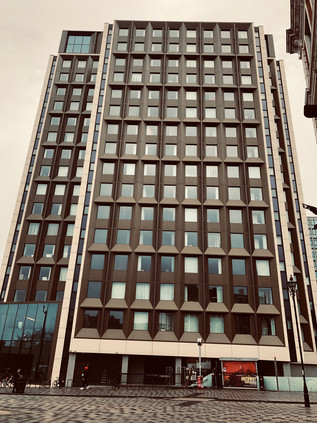
The tower was completed in 1963 by Oscar Garry and Partners, providing seventeen storeys of office accommodation for government departments, financially advantageous by being well outside the central area, but still eminently accessible by Tube with Northern Line station in the basement. By 1967, via a process of selling-off and leasing back, it provided offices for the then Department of Health and Social Security, which remained on two floors near the top of the building until 1994, a little after our awkward gig just along the Junction Road. For almost all of its existence, it has been despised by most locals and those passing artists and musicians who often decamped here from points north on their journey towards fame or infamy. The ground around the tower swirled will ill-winds, caused by pressure differentials around the stark sides of the building, and the rite of passage of attending a dehumanising interview in the building to obtain benefits seems to have been amplified in horror by the looming fabric of the tower. As buildings go, it doesn't appear an especially terrible one - but it is perhaps hard to love because of its imposition on the low-rise suburbia around it. Archway developed slowly in the 19th century as the slums of Somers Town and Camden were cleared and railways threaded into the city, and the terraces of London Brick which gradually filled the lower flanks of Highgate Hill weren't built to bear this overshadowing behemoth, clad for much of its working life in gloomy black marble. My own memory returns as I catch sight of the glowing blue of the station sign beneath the tower: walking up Junction Road into an eddy of people and traffic, dodging beggars and drunks who were haphazardly tottering away from the tower as if repelled by its magnetism. We paused at the station entrance to meet a friend of one of our party arriving from a long trip in from Sheffield. She was late, the single working escalator disgorged endless passengers, but never her. Finally, her knitted hat peeked over the emerging steps, shoulders hunched against the city, looking small and a little terrified at the prospect of Archway being slowly revealed to her as she rose. My friend threw himself onto the filthy cigarette-strewn pavement in relief at her arrival, oblivious to the ominous dark stains creeping from the walls. Above us, with no light left to reflect from it, the building disappeared entirely into the darkening night sky. It appeared to me rather like the object on the cover of Led Zeppelin's 'Presence' - an ill-defined and inert but obviously sinister absence of a thing.
The tower lay empty for some years while rumours of demolition and gentrification competed for column inches in the local press. No-one agreed on the right course of action - and everything was unfunded and impossibly hard to accomplish while Archway was essentially a huge island in the strategic road network. The local eyesore was, however, a rallying point for the discussion about what Archway could become. In 2012 an art installation by Ruth Ewan used technology to present a live view of the Island site without the tower. It was memorialised in a booklet of reminiscences called How to Make Archway Tower Disappear which included the stories of workers from the DSS office, musicians, artists and local residents. Among them, the comments of local MP Jeremy Corbyn stand out: for him, the tower was a deliberate brutality wrought on the poor - both those employed by the state and the unemployed who plead their cases to them. He fuses form with function, seeing the Tower's rather unremarkable 1960s vernacular as an assault on an older London. A pre-welfare state London which was surely less fair and more precarious to live in perhaps? The non-committal nature of his localism stretches into the current political unravelling, and the question remains where are any of us, actually from? There's no plan in all this - just an appeal to an impossible, distant past on all sides. Apparently the most remarkable aspect of the tower was the view across London in every direction from the upper floors:
There are some nice parts of London You can see them from hereThe site was finally redeveloped and rebranded as Vantage Point in 2016 and today is clad in neutral tones, fading into the winter skies and only reflecting a little light back from carefully tinted window panes. The slab-like visage to the north and south is mute and softened by the cladding and it begs to be ignored as an unremarkable residential block. It is still, by far, the tallest building for some way around, despite competition from its contemporary 1970s neighbour, Hill House which now shimmers in mirrored glass, bouncing light onto the new pedestrian area outside the utilitarian, stocky brick Post Office. Whether it was the opposing wind channelling along the new market square or the magnetic force of the monolithic building, it was hard to escape the drag of the Tower. I briefly considered a diversion to find the site of our musical endeavours along the street, but there was too little time, and while the sky was clearing to reveal a brightness ahead, the sun was fast sinking. I wanted to reach the city in the light so I headed on towards it, passing into the edges of Holloway.Saint Etienne, 'Archway People', 1993
The Great North Road has its very origins in Holloway with a new road opened by the Bishop of London, owner of much of the land around Highgate Hill, by 1318. This safer, straighter escape from the city laid the foundations of the direct route north which survives at least as far as Archway where newer alignments take over. Much else about Holloway is unclear - and while tempting to understand its name as a rural hollow-way, worn deeply into the ground by the cattle heading for Smithfield, it is as likely to be a reference to the Hallowed Way to pilgrimage at Walsingham. In either case, modern Holloway bore little relationship to either a via sancta or an ancient cattle track. The much-improved pavements were broad and busy, carrying steady traffic from the station at Upper Holloway to the Tesco Metro and Sainsbury's Local which fronted up to the curious brick missile silo of St. Gabriel of Our Lady of Sorrows. The area fizzed with energy largely due to the presence of residential accommodation for students which is strung between the Archway Campus of Central St. Martins and the dour, overhanging concrete tower of London Metropolitan University. In the midst of this was Emirates Stadium, home to Arsenal and on any other Saturday, a little over 60,000 of their devout. Today, the team was across town, playing at West Ham's London Stadium in the midst of the Olympic Park. The eateries and pubs of Holloway were busy, but not overwhelmed and I longed to step in and rest in the increasingly fancy looking premises as I headed south and deeper into Inner London. I crossed a rubicon at Nag's Head - I'd passed through before, both on an excursion along the A503 to distant Wanstead and when I was heading back from an attempt on the North Circular. As such it felt like a boundary to a known London. A string of local businesses and familiar bookmarkers signs clustered alongside pound shops and takeaways, hugging the crossroads. It felt almost comfortingly typical - like I was home in a semi-suburban London I knew better. Beyond here, though I'd not walked much of the remaining route, I knew I was within the range of buses and trains which would get me back to somewhere near where I needed to be. My range anxiety melted away, and it became clear that it was perhaps the presence of slight frisson, a mild fear of the unknown which had kept my feet moving thus far. I felt heavy and tired, the remaining distance weighing on me as the road dwindled into a less important link between the City and the suburbs. It felt like the A1 was giving up on me, rather than the reverse. At Highbury Corner I felt myself pass through another shockwave of the nearing city - the station pulsed with activity, the population diversifying and the volume increasing. This felt like the London I'd known from my earliest visits. The darkness of Archway couldn't penetrate this far, the Tower was gone from my view now.
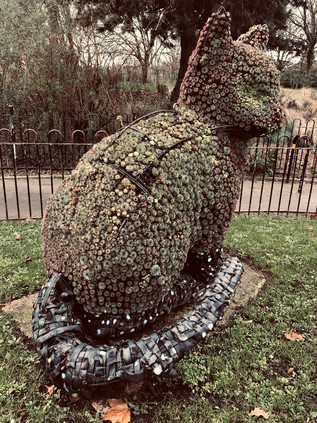
The pace accelerated, the city drew me in. Soon I was on Upper Street, with memories of snatched meals and happy reconvening after days spent walking. On Islington Green, Sir Hugh Myddleton stood guard, the remnants of his New River trickling underground now, streets away. Traffic careered around the junction and I realised what a destination in its own right this little corner had become. Shoppers filled the pavements, spilling into the road and precipitating attacks of honking as they blundered back onto the kerb. Despite the usually glum retail prospects for January, there were plenty of store-branded bags in evidence. Islington was fully gentrified, at odds with its radical associations and celebrated position as a centre of political influence. The seagulls, in particular, benefited hugely from the footfall, pecking at discarded scraps and strutting along the edge of the raised pavement. Since the 1960s the area has been dragging itself slowly up - terraces rejuvenated by middle-class owner-occupiers, cracked panes exchanged for CND stickers and wind-chimes on the porch. The district is home to a very specifically London kind of left-wing thought: intellectual rather than spiritual, honed in academia, hard to pin down and utterly dependent on the success of capitalism for its continued existence. This is where people voted to remain in the EU and can't for the life of them see why anyone wouldn't. This is where injustice is felt acutely and argued against loudly, but is often genuinely experienced just streets away with stoic silence. But, a kind of centrism which appals the true believers on both wings has its shameful heart on the sleeve of Islington. It's no surprise that the Blairs settled here on their journey to Downing Street. The people of Islington can win - or lose - elections for parties. These people hold the precarious balance of the Europe question, the next General Election, and probably the Bake Off final in their digits. In Britain, you always have to win the middle or lose the game. Jeremy Corbyn is duty bound to relentlessly play up his ascetic 'Good Life' credentials to continue living in the heart of the increasingly well-off, gentrifying Borough. There was, however, little sign of anti-capitalism today as Upper Street vibrated to the chirp of chip-and-pin transactions and steamed in the fragrance of chain restaurants. I pressed on, passing the Angel and crossing City Road. I was in very familiar territory now - inside the loop of the 205 bus route - but there were surprises still to be found. I'd never walked along the northern part Goswell Road - always preferring Bunhill Row or Whitecross Street to enter the City from the north with a nod to either George Gissing or William Blake. Suddenly, rearing above me like a chequerboard slab was Turnpike House. The entrance was via an elegant bow-like arch at the foot of the block, with tantalising hints of green space beyond. For the second time on this walk I thought of Saint Etienne. My appreciation of their work had begun early, with a crop of vital, life-affirmingly retrospective pop anthems which emerged in the 1990s. But we drifted apart: I found my niche in noisy low-fidelity art rock, and they strayed alarmingly into club territory. Worlds would occasionally collide in the following years with a snatched hearing of a new single or an appreciative glance at the ever glamorous Sarah Cracknell on TV, but I imagined that my London of grimy concrete and semi-industrial suburbs would never again align with their West End swagger and black-and-white movie chic. Then, almost a decade after I'd first heard them, a new side of Saint Etienne began to emerge: lyrics which read like Louis Macneice poems full of North Circular kitchen-sink drama, odes to suburbia, even a brace of films about London. The first of these Finisterre arrived in 2002, directed by Paul Kelly and scored by the band with a gritty, sometimes rather angular sounding electronic pulse. It was a hymn to the London of the early 21st century, but it drew unashamedly on the documentary films of the past, nodding knowingly at The London Nobody Knows along with the work of Patrick Keiller. The second film, What Have You Done Today, Mervyn Day? toured the site of the future Olympicopolis on those two fateful days in 2005: the announcement of the 2012 games coming to town, and the terrorist attacks on 7th July. Between these two anchors, Tales From Turnpike House was released. A gleefully London-themed pop opera of an album with a cast of almost depressingly real characters languishing, living and loving in an alienating, modern city. Bob Stanley and Pete Wiggs, unashamed Londonphiles and historians of the urban speculated that their Turnpike House would be somewhere in Croydon, on the fringe of London - but the clues were there: the architecture and alignment of the building was perfect, and The Birdman of EC1 lived in just the right postcode district.
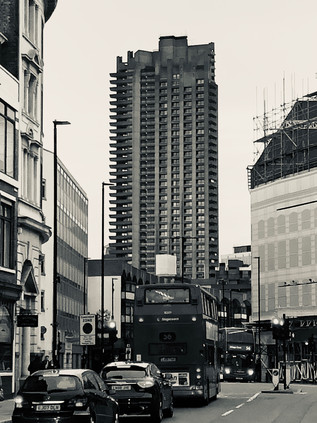
I paused for a while here, enjoying the modern sweep of the arch under the building - a shallow portal into the greenery beyond while the grid of flats began to light up in a cryptic coded pattern as residents arrived home. The block marked the edge of the City of London, an alternative portal to replace the former Aldersgate which would have given entrance to The Barbican. Now the three concrete towers of the Chamberlain Powell and Bon designed complex: Cromwell, Lauderdale and Shakespeare, aligned across my route in silhouette against the pale red of the sunset. Their jagged shadows adumbrated on the light I'd been walking towards all day. Aldersgate, spanning the Great North Road, was recorded as early as 1395 when the Lord Mayor's sword-bearer was gifted the mansion above the gate. It was rebuilt in 1617 and repaired after the Great Fire before finally being demolished in 1761. Now the ancient way was flanked by modern, anodyne commercial facades which were dark and quiet on a weekend afternoon. It wasn't always this way, and the street has more than a hint of the supernatural about it: here the Bishops of London were housed to shorten their journey from Fulham Palace to St. Paul's Cathedral, and in 1738 John Wesley underwent his profound religious experience and conversion to Methodism as recorded in The Aldersgate Flame, a sculpture sited nearby. Naturally, not all such experiences were what they seemed and in 1554 Elizabeth Crofts, a serving girl, was hidden in the wall of a house on Aldersgate Street, her disembodied 'heavenly voice' giving dire warnings about the consequences of the marriage of Catholic Queen Mary I to Prince Phillip of Spain. A crowd of around 17,000 attended over the following day to listen before the wall was demolished and Crofts discovered as its source. This final stretch - along the former Pickax Street - was hard on the feet, but was a strangely uplifting walk: a trip I hadn't dared to think would take place had led me along a route which had been unexpectedly compelling. I trudged through the low-rise blocks of the Golden Lane Estate, and circumnavigated the brick rotunda of The Museum of London which posed as a non-descript traffic island, from some angles at least. The dome of St. Pauls was looming between the crystalline reflections of the Barbican in the fascia of Cheapside offices which hid the little church of St. Vedast. The tourists lingered, aiming for a final shot of Paul's Cross in the golden hour, the sky a fine orange band behind the stark white ashlar of the building. I didn't really know where the A1 ended - or indeed began - but it couldn't go any further than the end of New Change where it met Cannon Street. I turned the corner to mark and ending at the point where I'd contemplated the possible loss of these walks back in December, in front of the Phoenix on the south door.
After lingering in the Cathedral precincts for a while, watching tourists wrapped up in winter gear framing their perfect selfies against an unforgivingly blank sky, I summoned the effort to trudge a little further, to Ludgate Circus and a familiar old coffee stop. Resting my feet there in the quiet, surrounded by students flicking at 'phone screens and staff gossiping about other crew-members, I reflected on today's walk - and on the optimistic chance that I'd be able to continue these walks despite my concerns at the end of the year. There was much to consider - new twists in my own tale to work into the coming months - but having broken ground on a new project, one which would see walking challenging miles in sometimes inhospitably non-pedestrian zones felt good. As ever, I agonised over the rules I'd impose on myself: I'd walked the 'modern' route of the A1 after all, not the ancient Great North Road - had I already invalidated my own plans? Or perhaps that walk, through the ancient villages of Middlesex, was a different walk again. At least, for now, it felt good to be contemplating the continuation of these trips.
A gallery of images from the walk is here.
Lost::MikeGTN
I've had a home on the web for more years than I care to remember, and a few kind souls persuade me it's worth persisting with keeping it updated. This current incarnation of the site is centred around the blog posts which began back in 1999 as 'the daylog' and continued through my travels and tribulations during the following years.
I don't get out and about nearly as much these days, but I do try to record significant events and trips for posterity. You may also have arrived here by following the trail to my former music blog Songs Heard On Fast Trains. That content is preserved here too.

